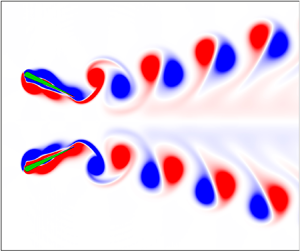Crossref Citations
This article has been cited by the following publications. This list is generated based on data provided by
Crossref.
Kang, Linlin
Peng, Ze-Rui
Huang, Haibo
Lu, Xi-Yun
and
Cui, Weicheng
2021.
Active external control effect on the collective locomotion of two tandem self-propelled flapping plates.
Physics of Fluids,
Vol. 33,
Issue. 10,
Yu, Huiyang
Liu, Bo
Wang, Chengyun
Liu, Xuechao
Lu, Xi-Yun
and
Huang, Haibo
2022.
Deep-reinforcement-learning-based self-organization of freely undulatory swimmers.
Physical Review E,
Vol. 105,
Issue. 4,
Chen, Zhe
Li, Xiong
and
Chen, Long
2022.
Enhanced performance of tandem plunging airfoils with an asymmetric pitching motion.
Physics of Fluids,
Vol. 34,
Issue. 1,
Lin, Xingjian
Wu, Jie
Yang, Liming
and
Dong, Hao
2022.
Two-dimensional hydrodynamic schooling of two flapping swimmers initially in tandem formation.
Journal of Fluid Mechanics,
Vol. 941,
Issue. ,
Liu, Xuechao
Liu, Kui
and
Huang, Haibo
2022.
Collective behavior and hydrodynamic advantage of side-by-side self-propelled flapping foils.
Physical Review E,
Vol. 105,
Issue. 6,
Yang, Dewu
and
Wu, Jie
2022.
Hydrodynamic Interaction of Two Self-Propelled Fish Swimming in a Tandem Arrangement.
Fluids,
Vol. 7,
Issue. 6,
p.
208.
Arranz, G.
Flores, O.
and
García-Villalba, M.
2022.
Flow interaction of three-dimensional self-propelled flexible plates in tandem.
Journal of Fluid Mechanics,
Vol. 931,
Issue. ,
Zhu, Yi
Pang, Jian-Hua
Gao, Tong
and
Tian, Fang-Bao
2023.
Learning to school in dense configurations with multi-agent deep reinforcement learning.
Bioinspiration & Biomimetics,
Vol. 18,
Issue. 1,
p.
015003.
Zeng, Yuhang
Wang, Yan
Yang, Dangguo
and
Chen, Qing
2023.
Immersed Boundary Methods for Simulations of Biological Flows in Swimming and Flying Bio-Locomotion: A Review.
Applied Sciences,
Vol. 13,
Issue. 7,
p.
4208.
Ren, Kai
Yu, Jiancheng
Chen, Zhier
Li, Hongbo
Feng, Hao
and
Liu, Kai
2023.
Numerical investigation on energetically advantageous formations and swimming modes using two self-propelled fish.
Ocean Engineering,
Vol. 267,
Issue. ,
p.
113288.
Chao, Li-Ming
Bhalla, Amneet Pal Singh
and
Li, Liang
2023.
Vortex interactions of two burst-and-coast swimmers in a side-by-side arrangement.
Theoretical and Computational Fluid Dynamics,
Vol. 37,
Issue. 4,
p.
505.
Jeong, Young Dal
Kim, Min Je
and
Lee, Jae Hwa
2023.
Intermittent swimming of two self-propelled flexible fins with laterally constrained heaving motions in a side-by-side configuration.
Journal of Fluid Mechanics,
Vol. 960,
Issue. ,
Wang, Yi
Wang, Zerong
Zhou, Chuangxin
and
Wang, Dou
2024.
Influence of flow interactions on the aerodynamic characteristics of tandem self-propelled flapping wings with a nonzero angle of attack.
Physics of Fluids,
Vol. 36,
Issue. 7,
He, Xu
Wang, Chao
Jia, Pan
and
Zhong, Zheng
2024.
The Effect of Hindwing Trajectories on Wake–Wing Interactions in the Configuration of Two Flapping Wings in Tandem.
Biomimetics,
Vol. 9,
Issue. 7,
p.
406.
Ormonde, Pedro C.
Kurt, Melike
Mivehchi, Amin
and
Moored, Keith W.
2024.
Two-dimensionally stable self-organisation arises in simple schooling swimmers through hydrodynamic interactions.
Journal of Fluid Mechanics,
Vol. 1000,
Issue. ,
Mabrouk, Mohamed Niged
and
Floryan, Daniel
2025.
Group cohesion and passive dynamics of a pair of inertial swimmers with three-dimensional hydrodynamic interactions.
Bioinspiration & Biomimetics,
Vol. 20,
Issue. 1,
p.
016014.
Wang, Yi
Wang, Zerong
Zhou, Chuangxin
and
Wang, Dou
2025.
Aerodynamic characteristics of tandem self-propelled flapping wings with asymmetric pitching motion.
Physics of Fluids,
Vol. 37,
Issue. 3,
Wang, Zerong
Wang, Yi
and
Wang, Dou
2025.
Proceedings of the 7th China Aeronautical Science and Technology Conference.
p.
435.




